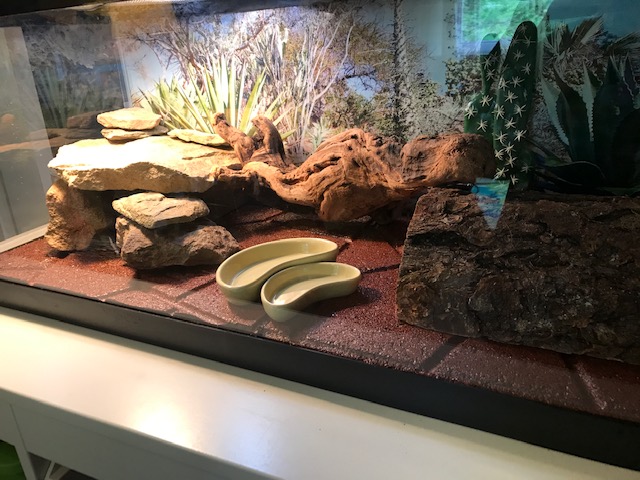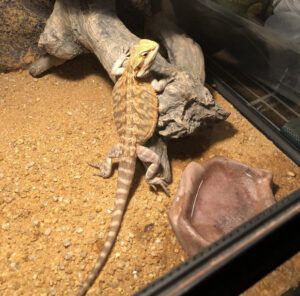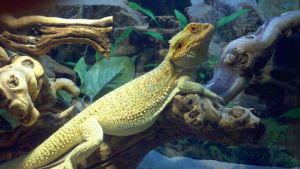The idea for any living being that resides inside an enclosed environment is to try to duplicate as close as possible to how it lives in the place it has evolved. As for Bearded Dragons they spend a great deal of time on the surface of our earth and also up high in trees and other flora.

First, Let’s Start with the Bad
There are various items that are sold in pet stores and on the internet for a dragon’s flooring. This ranges from a glued sandy material, carpeting, walnut shells, and other odd materials. Most are difficult to clean which can cause the dragon to be attracted to what is not picked up or dark marks which can cause a dragon to lick. Some are dangerous and can kill if ingested. Others can leave traces of fecal and also traces of live parasites. This in turn, if licked, can cause a gradual build-up of a parasite within the dragon.
Parasites are found in a lot of reptiles and animals that eat off the surface of the earth. Most have become good hosts over the millennia and help lots of living things to digest the nutrients they eat.
However, a dragon that lives in an enclosed terrarium should not have any extra parasites to deal with since an overabundance can cause a gradual decline and even death.
So, What Substrate Should You Use In Your Bearded Dragon Enclosure?
Baby Hatchling, Juvenile, Sub-adults and Other Small Dragons
For a baby beardie, Juvenile or other small dragon from hatchling to 10” in length I personally feel that this is where I must slightly differ in using a natural flooring such as sand in the beginning. The dragon is not on the surface of the earth. It is not subject to the vagaries of a natural environment. A small dragon that is purchased as a pet should be treated with every chance of care for survival and also for the convenience of the care giver.
A thin tile or vinyl that can easily be cut and inserted snugly against the walls of the terrarium would be excellent. The surface should be a bit rough in order for the dragon to walk comfortably. The texture should be such that it can quickly and easily be cleaned as well.
 Sub-adults should be on sand. Start at 10 or 12″ in length I consider those juveniles that can then be put on sand making sure that all heavy objects are placed on the bottom of the enclosure with the sand around them. We have seen a young dragon dig under a water bowl and not be able to get back out. It smothered.
Sub-adults should be on sand. Start at 10 or 12″ in length I consider those juveniles that can then be put on sand making sure that all heavy objects are placed on the bottom of the enclosure with the sand around them. We have seen a young dragon dig under a water bowl and not be able to get back out. It smothered.
Young Adult, Mature Adult and Old Age Dragons
Conflicting information on Sand is predominant on the internet as is most information written about when it comes to the care of bearded dragons. We have kept our dragons on sand and soil when outside since 1992. No issues have ever occurred and as most of our customers will contest to, our dragons have thrived as that is what they would live on in the wild.
Natural sand in a terrarium is for the dragons need and also for the beauty of the enclosure. Dragon’s burrow and dig. Having natural sand as a substrate will fill that desire to dig. Sand impaction can occur when purchasing a sand that is manufactured to a powdery medium. Often this dangerous sand has added calcium. Dragons love the flavor of calcium which is very important for their health. Calcium is found in both sand and soil since everything on the surface of the earth dies. In that death are minerals. Calcium is high in the mineral content. Once a dragon consumes the man-made crushed sand and drinks water. Sand impaction can occur.
All Purpose sand or Children’s Play sand is inexpensive and easy to find. Read the label and look at it before purchase. It should say kiln dried on the bag. This kills the living parasites that naturally live on the earth. If the sand has different sized granules or even small pebbles or is just regular sand then that’s what should be purchased.
Do Substrate Temperatures At Night Matter?
Simply put – YES! But is based on enclosure type, substrate and the bearded dragon’s personality.
Most terrariums are purchased as glass but not all. I would recommend and under the tank heater for glass terrariums making sure the heat percolates up thru the sand when housing in glass. All nighttime heaters should be put on a separate timer to come on one or two hours before lights out. For other enclosures or for the recommended substrate a heat emitter placed in a convenient sleeping spot is advised. We have found through many years of working with dragons, that some nights a dragon will want to sleep warm and other nights at colder temperatures. Even at a 50-degree nighttime temperature… Go figure!
There is always a downside to all decisions in life and since I have always suggested an under the tank heater that can be used at night. With these recommended substrates I have mentioned, temperature control becomes the downside of using these surfaces. Sand will quickly cool off and will remain warmer only where the heating pad is emitting heat. Ultimately, the dragon may dig down to get closer to the glass or bottom to get more heat which I typically try to avoid having happen especially with higher wattage/voltage pads. An easy remedy would be to use a heat emitter that throws no light and can be placed in a convenient and comfortable spot for the dragon to use if it chooses to do so while sleeping.
READ MORE INFORMATION ON BEARDED DRAGON ENCLOSURE & SET-UPS HERE!

